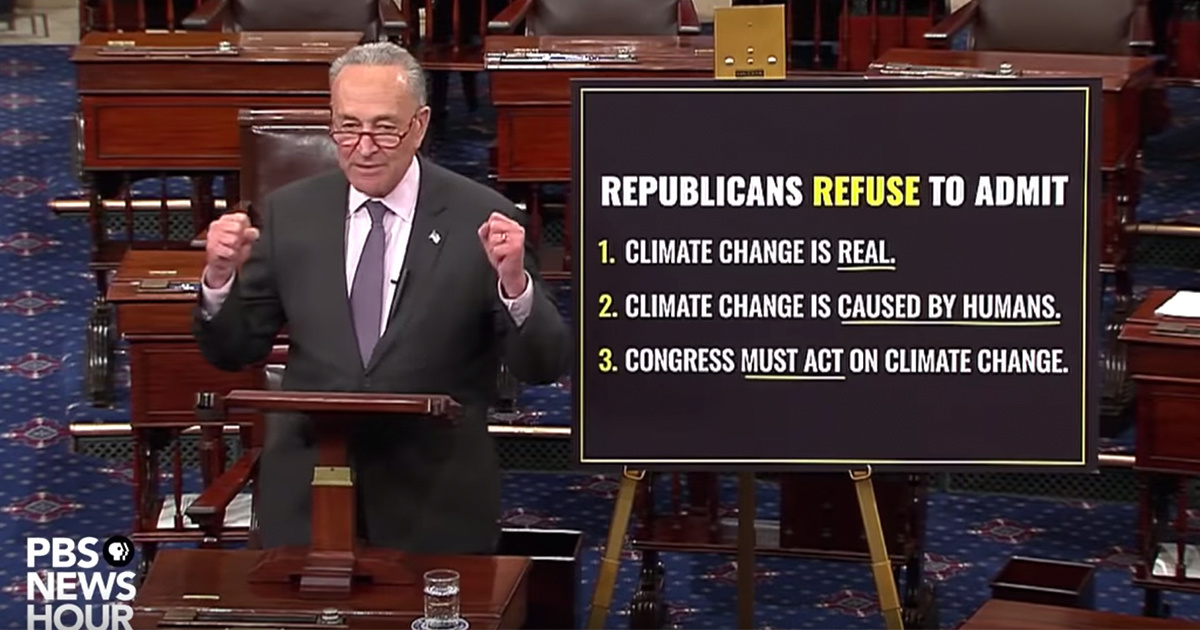
Senate Dems Vote ‘Present’ on Green New Deal to Foil McConnell’s Ploy

Senate Minority Leader Chuck Schumer spoke before the Senate vote on the Green New Deal on March 25. PBS NewsHour / YouTube screenshot
The Green New Deal ― an ambitious 10-year plan to transition the U.S. away from fossil fuels while promoting green jobs and greater equality ― failed to advance in the Senate Tuesday after most Democrats voted “present” in an attempt to forestall a Republican ploy to exploit disagreements within the party.
Senate Majority Leader Mitch McConnell had been clear about his intention to put the resolution to an up or down vote in an attempt to force Democrats to support or oppose the controversial measure ahead of the 2020 election, CNN reported. Climate activists and the proposal’s House co-sponsor and leading champion Alexandria Ocasio-Cortez had given Senate Democrats the greenlight to vote “present” in an attempt to slight McConnell, Vox reported. Ocasio-Cortez said McConnell’s manipulations suggested Republicans were not taking climate change seriously.
“The Senate vote is a perfect example of that kind of superficial approach to government,” Ocasio-Cortez said Tuesday, according to Vox. “What McConnell’s doing is that he’s trying to rush this bill to the floor without a hearing, without any markups, without working through committee — because he doesn’t want to save our planet. Because he thinks we can drink oil in 30 years when all our water is poisoned.”
Because I encouraged them to vote present, along w/ others.
McConnell tried to rush the #GreenNewDeal straight to the floor without a hearing.
The real question we should be asking: Why does the Senate GOP refuse to hold any major hearings on climate change? https://t.co/de8oKOXeJf
— Alexandria Ocasio-Cortez (@AOC) March 26, 2019
The measure was defeated 57-0, The Guardian reported, meaning it failed to get the 60 votes necessary to advance to a final vote, the Huffington Post pointed out. Three Democrats and one Independent, Maine Senator Angus King, joined with all 53 Republicans in voting “no.”
The Democrats who broke ranks to vote against the measure all come from conservative-leaning states. They were Joe Manchin of West Virginia, Kyrsten Sinema of Arizona and Doug Jones of Alabama.
Manchin said that he wanted to focus on “real solutions that recognized the role fossil fuels will continue to play,” according to a statement reported by CNN.
“We cannot successfully address our climate challenge by eliminating sources of energy that countries are committed to using,” he said.
Manchin is notoriously pro-coal and has received almost million in campaign contributions from the fossil fuel industry over the course of his career. In total, the senators who voted “no” Tuesday have received more than ,000,000 in contributions from fossil fuel companies, Oil Change United States reported.
While the Green New Deal isn’t advancing right now, its first Senate sponsor Massachusetts Democrat Ed Markey said it had done a good job of sparking a national debate about climate change.
“This resolution has struck a powerful chord with the American people,” Markey said at a Monday press conference reported by the Huffington Post. “The Green New Deal was always designed to be an opening of a national discussion. And it has worked. In just six short weeks, everyone is debating a Green New Deal. There’s been more debate about climate change in the last six weeks than in the last six years.”
Every senator running for president in the 2020 Democratic primary has co-sponsored the measure, among them California’s Kamala Harris, Massachusetts’ Elizabeth Warren, Vermont’s Independent Bernie Sanders, New Jersey’s Cory Booker, New York’s Kirsten Gillibrand and Minnesota’s Amy Klobuchar.
While the Sunrise Movement, the grassroots group that has worked to popularize the deal, endorsed the strategy of voting “present,” they will now continue to pressure Senate Minority Leader Chuck Schumer to co-sponsor the measure.
“We particularly want Sen. Schumer to continue to make climate change central to his agenda and come through and back the Green New Deal,” Sunrise Movement spokesperson Stephen O’Hanlon said, as Vox reported.
Meanwhile, during a House financial services committee hearing, Ocasio-Cortez continued her outspoken advocacy for environmental action, reacting strongly against the idea that it was an elitist concern. A video of her speech had been shared thousands of times by Tuesday night, The Guardian reported.
“This is about our lives, and this should not be partisan,” she said in the clip. “Science should not be partisan.”
Watch every second of this… @AOC is so incredibly spot on. pic.twitter.com/ESP4dC5TTo
— Brian Tyler Cohen (@briantylercohen) March 27, 2019
Climate Change Is an Existential Crisis—It Should Be the Top Political Issue, Too https://t.co/TLF31z1oEZ #Climatechange #Canada #Carbontax pic.twitter.com/RpkodPEwFg
— Tom DeRosa (@RenewableSearch) January 12, 2019
- House Democrats Hold First Climate Change Hearings in More ...
- The Best and Worst Midterm Results for the Environment - EcoWatch

 233k
233k  41k
41k  Subscribe
Subscribe 